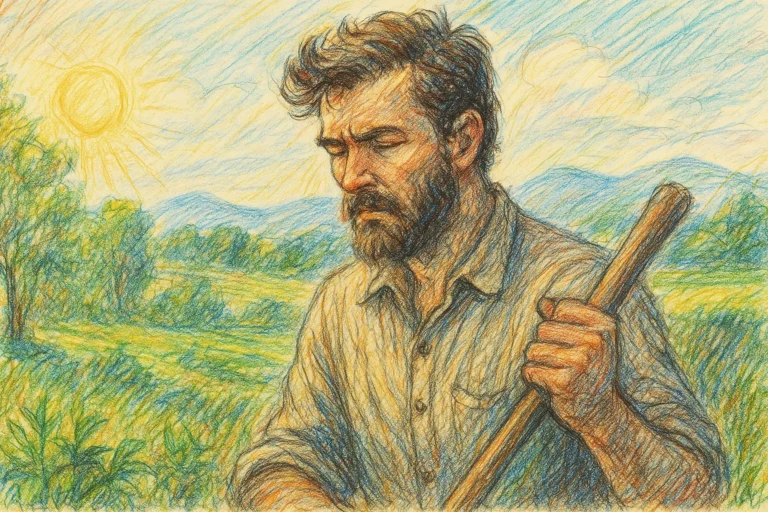Awakening the Sage Within
Awakening the Sage Within
Navigating Life Through the Wisdom of the ‘Wise Old Man’ Archetype
Introduction
The human psyche has always been intrigued by symbols, patterns, and characters that resonate universally across cultures and epochs. At the heart of this collective consciousness lie archetypes — recurring themes and motifs that have been employed in tales, myths, and narratives throughout history.
“Archetypes are the unconscious images of the instincts themselves, in other words, they are patterns of instinctual behavior.” – Carl Jung
Background on Archetypes
Archetypes can be viewed as the shared, innate, and universal mental structures that inform human experience. These deep-seated patterns, motifs, or symbols shape how individuals perceive the world and respond to it. They appear in various forms, ranging from characters and themes to scenarios and symbols, and can be found sprinkled across the literature, art, and folklore of different cultures.
“Archetypes, in spite of their conservative nature, are not static but in a continuous dramatic flux. Thus, the self as a monad or continuous unit would be dead. But it lives inasmuch as it splits and unites again. There is no energy unless there is a tension of opposites.” – Carl Jung
Importance of the “Wise Old Man” in Myth and Storytelling
Among the vast sea of archetypes, the “Wise Old Man” stands as a beacon of knowledge, guidance, and mentorship. Whether it’s Merlin guiding King Arthur or Yoda instructing Luke Skywalker, the Wise Old Man represents a source of enlightenment, a bridge between the known and the unknown. This figure embodies the accumulated wisdom of age and the profound insights that come from a life well-lived. Their role is to guide the hero, often a younger, less experienced individual, through trials and tribulations, helping them navigate the complexities of life.
“The old know what they want; the young are sad and bewildered.” – Logan Pearsall Smith
In narratives, the presence of the Wise Old Man often signals a turning point, a moment of revelation, or the bestowal of essential knowledge. Their guidance is invaluable, offering both practical advice and profound philosophical insights. Their timeless wisdom not only enriches the tapestry of stories they inhabit but also provides readers and viewers with valuable life lessons.
“Wisdom is the reward you get for a lifetime of listening when you’d have preferred to talk.” – Doug Larson
In understanding the “Wise Old Man”, we tap into the age-old human desire for guidance, for a compass in the bewildering journey of life. This archetype reminds us of the importance of listening, learning, and leaning on the wisdom of those who have walked the path before us.
By delving into the depths of the “Wise Old Man” archetype, we not only uncover the treasures of ancient myths and stories but also discover timeless lessons that can guide our personal journeys.
Historical Context
The fabric of human history is richly woven with tales of wisdom, guidance, and mentorship. Embedded within this tapestry is the recurrent image of the “Wise Old Man”, an archetype that has held the collective imagination of societies across the ages. Tracing its origins and manifestations provides us a glimpse into our shared human story, where wisdom is both sought after and revered.
“History is the essence of innumerable biographies.” – Thomas Carlyle
Origins of the “Wise Old Man” Archetype
The “Wise Old Man” can be traced back to the earliest civilizations. Ancient societies, with their reverence for ancestors and the elderly, often attributed wisdom to age and experience. The old were seen as repositories of knowledge, having lived through seasons of change, challenges, and triumphs. It’s no surprise that in many ancient cultures, the elder was a revered figure, consulted in times of uncertainty and looked upon as a mediator between the mortal realm and the divine.
“Wisdom is the daughter of experience.” – Leonardo da Vinci
Ancient cave paintings, folklore, and oral traditions frequently portrayed older individuals as seers, shamans, or wise counselors. They were believed to possess insights into the mysteries of life, death, and the cosmos, earned through years of reflection and observation.
Prominent Examples from Ancient Texts and Myths
- Confucius from Chinese tradition: Confucius, with his profound wisdom, played a pivotal role in shaping the moral and philosophical landscape of ancient China.
“Real knowledge is to know the extent of one’s ignorance.” – Confucius
- Solomon from Biblical lore: King Solomon of Israel was famed for his unparalleled wisdom, rendering judgments and proverbs that are celebrated to this day.
“The fear of the LORD is the beginning of wisdom, and knowledge of the Holy One is understanding.” – Proverbs 9:10
- Odin from Norse mythology: Often depicted as an old man with a single eye, Odin sacrificed an eye at Mímir’s well in exchange for wisdom and is regarded as the god of poetry, war, and wisdom.
“Cattle die, kinsmen die; oneself too soon must die, but glory never dies, for the man who can achieve it.” – Hávamál (Sayings of the High One, attributed to Odin)
- Ptahhotep from ancient Egyptian texts: A vizier from the Old Kingdom, Ptahhotep wrote a series of maxims, offering moral and practical advice for living.
“Be not arrogant because of that which you know; deal with the ignorant as with the learned; for the barriers of art are not closed, no artist being in possession of the perfection to which he should aspire.” – Maxims of Ptahhotep
Through these figures and many more, the “Wise Old Man” has played a pivotal role in shaping the ethos of ancient societies. They served as touchstones for moral integrity, ethical behavior, and the pursuit of knowledge. Their stories, preserved in texts and myths, continue to inspire, reminding us of the enduring value of wisdom across ages and cultures.
Characteristics of the Wise Old Man
Throughout the annals of history, literature, and myth, the “Wise Old Man” has remained a constant figure, symbolizing various virtues and attributes that resonate deeply within the human psyche. Delving into the characteristics of this archetype can offer insights into why it holds such an enduring and universal appeal.
“Wisdom is not a product of schooling but of the lifelong attempt to acquire it.” – Albert Einstein
Timelessness and Universality
Across cultures, continents, and epochs, the figure of the “Wise Old Man” emerges, seemingly transcending temporal and geographic boundaries. Whether in the tribal tales of Africa, the ancient scrolls of Asia, or the classical texts of Europe, this archetype is a testament to its universal resonance.
“Time is a created thing. To say ‘I don’t have time,’ is like saying, ‘I don’t want to.'” – Lao Tzu
This timelessness underscores a fundamental human yearning — the search for wisdom, understanding, and a guiding force in a world filled with uncertainty.
Profound Wisdom and Guidance
Central to the “Wise Old Man” is the treasure trove of wisdom he possesses. More than mere knowledge, it’s a deep understanding of life, its intricacies, challenges, joys, and sorrows. This wisdom often illuminates paths, offers solutions, or simply provides comfort.
“The only true wisdom is in knowing you know nothing.” – Socrates
The guidance offered is not just practical but also moral and ethical, steering the seeker towards not just success, but righteousness and virtue.
Symbolism of Patience and Maturity
The “Wise Old Man” is often depicted as someone who has weathered many storms, seen numerous seasons pass, and has thus developed an innate patience. This patience is mirrored in their demeanor, in their measured words, and their ability to wait for the right moment.
“Patience is the companion of wisdom.” – Saint Augustine
Maturity, both in age and insight, further accentuates this patience. It’s not just about the years lived, but the lessons learned, the reflections made, and the insights gained.
Embodying Experience and Insight
Life’s greatest teacher is often said to be experience. The “Wise Old Man” embodies this sentiment, having walked the long road of life, with its peaks and troughs, joys and sorrows.
“Experience is not what happens to a man; it is what a man does with what happens to him.” – Aldous Huxley
This wealth of experience translates into insights — about human nature, about the world, about the mysteries of existence. These insights are the gems that the “Wise Old Man” shares with those who seek him out, shedding light on the most profound and perplexing of quandaries.
In encapsulating these characteristics, the “Wise Old Man” stands as a beacon, lighting the path for those who traverse the intricate maze of life. His virtues and attributes serve as a reminder of the timeless values that can guide one through the ever-evolving journey of existence.
Understanding the Psychological Significance
In the vast expanse of human psychology, archetypes such as the “Wise Old Man” are not mere products of literature or myth but are deeply rooted in the collective unconscious. They bear significance that transcends tales and resonates with the very essence of human understanding and behavior.
“The meeting of two personalities is like the contact of two chemical substances: if there is any reaction, both are transformed.” – Carl Jung
Carl Jung and the Collective Unconscious
Swiss psychiatrist Carl Jung delved deep into the realm of the human psyche, unearthing the concept of the ‘collective unconscious.’ According to Jung, this is a realm of shared memories, ideas, and archetypes, common to all humans and inherited from our ancestors.
“The collective unconscious consists of the sum of the instincts and their correlates, the archetypes. Just as everybody possesses instincts, so he also possesses a stock of archetypal images.” – Carl Jung
The “Wise Old Man” emerges as one such archetype from this reservoir. Its repeated manifestation across cultures and epochs is a testament to its deep-seated presence in the human psyche. The archetype symbolizes guidance, wisdom, and the quest for understanding, resonating with the universal human journey towards enlightenment and self-realization.
The Wise Old Man as a Mentor in the Hero’s Journey
Popularized by Joseph Campbell, the “Hero’s Journey” or the “monomyth” is a narrative pattern that describes the typical adventure of the archetype known as the Hero. Central to this journey is the mentor or the guide, often personified by the “Wise Old Man.”
“The cave you fear to enter holds the treasure you seek.” – Joseph Campbell
In this narrative structure, the mentor provides the hero with guidance, tools, wisdom, and sometimes, a nudge to confront their deepest fears. Their role is instrumental in shaping the hero’s path, helping them navigate challenges, confront their inner demons, and eventually, realize their potential.
“One of the most universal symbols of the Wise Old Man…is the teacher or magician who instructs the future hero or assists him in a crucial situation.” – Carl Jung
Be it Merlin guiding young Arthur, Dumbledore mentoring Harry Potter, or Yoda enlightening Luke Skywalker, the “Wise Old Man” in the avatar of the mentor is a transformative force in the Hero’s journey.
By understanding the psychological significance of the “Wise Old Man”, we begin to grasp the depth and breadth of its influence on human consciousness. It underscores the innate human need for guidance, the quest for deeper understanding, and the timeless journey of self-discovery.
Applications in Personal Development
The “Wise Old Man” archetype, while rooted in ancient myths and narratives, has profound relevance in the context of modern personal development. By understanding and integrating the principles embodied by this figure, individuals can navigate the complexities of life with greater wisdom, clarity, and purpose.
“We do not grow absolutely, chronologically. We grow sometimes in one dimension, and not in another; unevenly. We grow partially. We are relative. We are mature in one realm, childish in another.” – Anaïs Nin
Seeking Mentors in Modern Life
In today’s fast-paced world, the guidance of a mentor—someone who embodies the qualities of the “Wise Old Man”—can be invaluable. Such mentors provide insights based on their experiences, offer perspectives that challenge our thinking, and guide us in personal and professional growth.
“A mentor is someone who allows you to see the hope inside yourself.” – Oprah Winfrey
Whether in academia, business, or personal endeavors, seeking out and fostering relationships with mentors can provide direction, clarity, and the wisdom of experience.
Reflecting on Personal Experiences
Life offers lessons at every turn. By actively reflecting on our experiences, we can internalize the wisdom they offer, much like the “Wise Old Man” who embodies the insights gleaned from a life well-lived.
“Life can only be understood backwards; but it must be lived forwards.” – Søren Kierkegaard
Regular self-reflection, journaling, and contemplation allow us to distill wisdom from our experiences, ensuring that we not only live but also learn and grow.
Embracing Patience and Long-term Thinking
The “Wise Old Man” archetype exemplifies patience and the ability to see the bigger picture. In our instant-gratification culture, embracing patience and long-term thinking stands as a counterpoint, guiding us to make decisions that yield lasting benefits.
“Patience, persistence and perspiration make an unbeatable combination for success.” – Napoleon Hill
By cultivating patience, we learn to approach challenges with equanimity, make thoughtful decisions, and appreciate the journey as much as the destination.
Meditation and Introspection
Meditation and introspection are powerful tools for cultivating an inner sage. They allow us to tap into our inner wisdom, gain clarity, and find guidance within ourselves.
“The soul always knows what to do to heal itself. The challenge is to silence the mind.” – Caroline Myss
By practicing regular meditation and introspection, we not only enhance our mental clarity and focus but also foster a deeper connection with our inner “Wise Old Man”, allowing its wisdom to guide our choices and actions.
Incorporating the principles embodied by the “Wise Old Man” into personal development strategies offers a holistic approach to growth—one that combines age-old wisdom with modern insights. It serves as a reminder that while the challenges of life may evolve, the core principles of wisdom, patience, and introspection remain timeless guides.
Challenges and Pitfalls
While the archetype of the “Wise Old Man” serves as an invaluable guidepost in our quest for wisdom and personal growth, it’s essential to recognize potential challenges and pitfalls associated with it. By being aware of these, one can strike a balance and integrate the archetype’s teachings more effectively.
“Wisdom is oftentimes nearer when we stoop than when we soar.” – William Wordsworth
Avoiding Over-reliance on External Wisdom
One of the primary challenges in seeking wisdom is the potential over-reliance on external sources. While mentors and guides can provide insights, it’s vital for personal development to cultivate one’s inner wisdom.
“Know thyself.” – Socrates
Over-dependence on external wisdom can prevent us from trusting our judgment and intuition. It’s essential to strike a balance—valuing external guidance while also nurturing and trusting our inner compass.
Distinguishing Genuine Wisdom from Superficial Knowledge
In an age where information is abundant, there’s a risk of mistaking knowledge for wisdom. While knowledge is the accumulation of facts and information, wisdom involves understanding, insight, and the application of knowledge to life’s complexities.
“Information is not knowledge. The only source of knowledge is experience.” – Albert Einstein
It’s crucial to discern between the two and seek genuine wisdom, which often comes from experience, reflection, and depth of understanding, rather than merely accumulating data.
Dynamic Nature of Wisdom
Wisdom isn’t a static state but a dynamic process. What might be considered wise in one context or era might not hold in another. Therefore, it’s imperative to recognize the evolving nature of wisdom and the importance of continuous learning.
“Live as if you were to die tomorrow. Learn as if you were to live forever.” – Mahatma Gandhi
The “Wise Old Man” archetype, while rooted in age-old traditions, also embodies the idea of continuous growth and learning. It’s a reminder that the pursuit of wisdom is a lifelong journey, requiring adaptability, openness, and humility.
By being aware of these challenges and pitfalls, individuals can more effectively harness the wisdom embodied by the “Wise Old Man” archetype, ensuring that it serves as a guide, not a crutch, in their personal development journey.
Practical Exercises for Embracing the Wise Old Man Within
To harness the power and wisdom of the “Wise Old Man” archetype within oneself, integrating it into daily practices can be profoundly transformative. Here are some practical exercises, paired with enlightening quotes, to help embrace the internal sage that resides within each of us.
“The unexamined life is not worth living.” – Socrates
Daily Reflections and Journaling
Purpose: To distill insights from daily experiences, recognize patterns in thought and behavior, and gain clarity on personal goals and aspirations.
Exercise: Dedicate a few minutes each day to reflect on your experiences. Consider challenges faced, emotions felt, and lessons learned. Pen down these reflections in a journal, creating a tangible record of your journey.
“I can shake off everything as I write; my sorrows disappear, my courage is reborn.” – Anne Frank
By consistently engaging in this practice, one can cultivate a deeper understanding of oneself and chart a path toward personal growth and wisdom.
Meditation Practices for Inner Guidance
Purpose: To connect with one’s inner self, cultivate mindfulness, and access the wellspring of wisdom within.
Exercise: Begin with simple breathing exercises. Sit in a comfortable position, close your eyes, and focus on your breath. As thoughts arise, observe them without judgment and return your focus to your breath. With practice, delve into guided meditations or specific practices like loving-kindness or body scan meditations.
“Quiet the mind, and the soul will speak.” – Ma Jaya Sati Bhagavati
Regular meditation not only enhances mental clarity and reduces stress but also fosters a deep connection with the inner “Wise Old Man”, allowing its insights to illuminate your path.
Engaging in Lifelong Learning and Curiosity
Purpose: To continually expand one’s horizons, embrace new perspectives, and understand the dynamic nature of wisdom.
Exercise: Dedicate time to learn something new regularly. This could involve reading books, attending workshops, enrolling in online courses, or simply engaging in stimulating conversations. Embrace curiosity by asking questions and seeking to understand diverse viewpoints.
“It is not that I’m so smart. But I stay with the questions much longer.” – Albert Einstein
By nurturing an insatiable curiosity and commitment to lifelong learning, one aligns with the ever-evolving, dynamic nature of wisdom, echoing the adaptability and depth of understanding embodied by the “Wise Old Man”.
Incorporating these practical exercises into daily routines can serve as stepping stones on the journey to internalizing the wisdom of the “Wise Old Man” archetype. By actively engaging in self-reflection, meditation, and continuous learning, we not only honor this timeless figure but also pave the way for our personal evolution.
Conclusion
As we journey through the multifaceted terrain of human existence, archetypes like the “Wise Old Man” emerge not just as relics of bygone eras, but as enduring beacons that illuminate our paths. They whisper age-old truths and invite us to partake in the universal dance of wisdom and self-discovery.
“In wisdom gathered over time I have found that every experience is a form of exploration.” – Ansel Adams
The Timeless Relevance of the “Wise Old Man”
Despite the rapidly changing world and the complexities of modern life, the essence of the “Wise Old Man” remains ever relevant. This archetype serves as a testament to the human spirit’s perpetual quest for understanding, growth, and transcendence. It’s a symbol that reminds us that wisdom is not just the domain of the aged, but is accessible to anyone willing to seek, reflect, and learn.
“The doorstep to the temple of wisdom is a knowledge of our own ignorance.” – Benjamin Franklin
Encouraging Readers to Forge their Own Path of Wisdom
While the “Wise Old Man” provides a blueprint, it’s up to each individual to forge their unique path. Wisdom is not a one-size-fits-all concept; it’s an ever-evolving journey, shaped by experiences, choices, and introspections.
“Do not go where the path may lead, go instead where there is no path and leave a trail.” – Ralph Waldo Emerson
As you, dear reader, navigate the tapestry of life, may you find the courage to carve out your path of wisdom, to question, to learn, and to grow. Remember, the journey itself is as enriching as the destination, and every step, every challenge, every joy and sorrow, contributes to the mosaic of your wisdom.
“Your own self-realization is the greatest service you can render the world.” – Ramana Maharshi
In embracing the lessons of the “Wise Old Man”, and more importantly, in forging your unique wisdom narrative, you not only enrich your life but also contribute to the collective wisdom of humanity. The torch has been passed; now, it’s your turn to shine its light.







